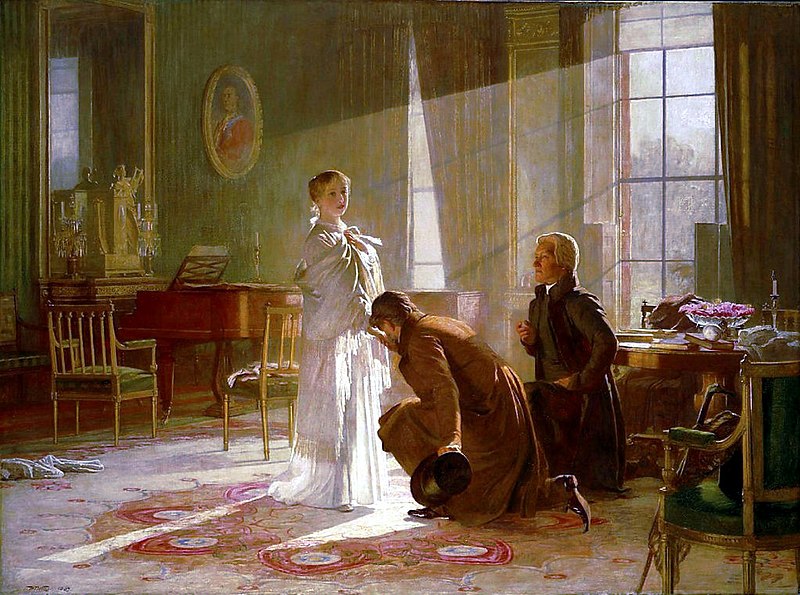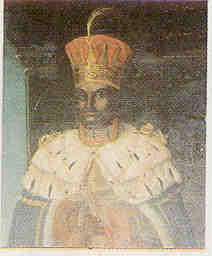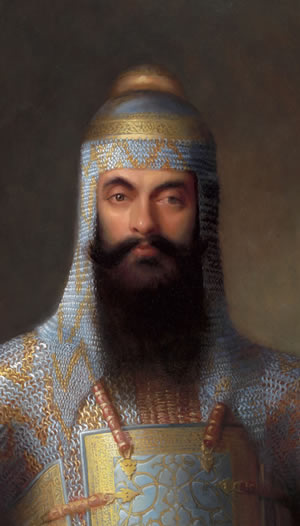In India
 |
| George Eden |
In September
1835 George was appointed Governor-General of India[i]. It was from her firm sense of duty, and of course
her love for this favourite of her siblings, that Emily elected to accompany
her brother. George, Emily and Fanny arrived, along with their nephew William
Godolphin Osborne, who was to be George’s military secretary, in Calcutta in
March 1836 after a five month voyage. They landed on Emily’s birthday, she was
thirty-nine.
George had
as his private secretary John Colvin. George’s staff also included William Mcnaghten as his political secretary and his
assistant Henry Torrens.
The first 20
months of George’s appointment the Edens spent in Calcutta; during the week at Government House and at the weekends at Barrackpore
House[ii]. Emily hated the very
formal life in Calcutta; the rigorous social obligations that had to be met, no
matter how ill the climate made one feel. According to her the society was ‘second rate’ and there were very few
topics of conversation.
On 20th
June 1837 the old king died and in his place his young niece, Victoria, came to the throne. The inexperienced young queen was to become very
dependent on her fatherly and urbane Prime Minister Lord Melbourne. It was not
until 30th October that Emily, by then 200 miles distant from
Calcutta, learnt of the passing of an age;
‘I think the young Queen a
charming invention, and I can fancy the degree of enthusiasm she must excite.
Even here we feel it. The account of her proroguing Parliament gave me a lump
in my throat.’[iii]
Up Country
In the
autumn of 1837 Emily accompanied George on an official progress ‘up-country’ and
it is her letters to her sister Mary Drummond that give us details of the travels
of the Governor-General in colonial India. George intended to familiarise
himself with the East
India Company territory stretching from Calcutta to the River Sutlej in the north. George also wished to consolidate the 1831
treaty of friendship between Britain and the Maharajah of the Punjab[iv], Ranjit Singh.
The Sunderbunds
The party
left Calcutta on the 21st October 1837 by steamer for the first 3 ½
weeks through the Sunderbunds and up the Ganges. On 15th November the Governor and his entourage camped at Benares. By the end of November the party were travelling overland to Simla, using 850 camels, 140 elephants and hundreds of horses and bullocks.
Nawab of Oudh
There were
12,000 people travelling in the governor’s wake and it could take three days
for the ten mile long caravan to cross a river. The Nawab of Oudh sent his chef to cook for the Governor General; much
affronting St Cloup, George’s own chef, who had previously worked for the Prince of Orange. The Edens were accompanied by
George’s staff and their families[v].
At their
halts the Edens and their entourage met with the British living in the
vicinity, but of course society morality still prevailed;
‘There was a lady yesterday
in perfect ecstasies with the music. I believe she was the wife of an indigo
planter in the neighbourhood, and I was longing to go and speak to her, as she
had probably not met a countrywoman for many months; but then, you know, she
might not have been his wife, or anybody’s wife.’[vi]
Cawnpore from the Ganges
‘You cannot conceive the
horrible sights we see, particularly children; perfect skeletons in many cases,
their bones through their skin, without a rag of clothing, and utterly unlike
human creatures.’[vii]
The Edens
began distributing food, but their attempts were minimal compared to the
problems; one of the party saw three villagers drop dead of starvation. Three
days after the first distribution of supplies they came across worse
deprivation; 700 people were fed but the violence that erupted required
policing.
Victoria was
crowned on the 28th June 1838, but, so very unlike later Victorians,
Emily makes no mention of the event in her letter of that date; instead she
mentioned;
‘We had a musical dinner
yesterday; a borrowed pianoforte and singing, and two couples who accompany
each other. The flute couple I think a failure, but they are reckoned in this
country perfectly wonderful……the other couple are beautiful musicians.’[viii]
A Successful Expedition
Lord Palmerston
George was,
like Palmerston[ix], an anti-Russian politician and this led him to
dabble in affairs in Afghanistan with disastrous consequences[x]. George listened to
advisers whose proposals he believed would secure the north-west frontier. The
plan of action involved going over the Khyber Pass, at the same time marching the army through Sind in violation of an 1832 treaty[xi], using the Persians siege
of Herat as an excuse.
Ranjit Singh
had ensured that the British would take the lead in restoring Shah Shuja to his
throne. The Commander in Chief of British forces in India disapproved of the
plan and Wellington, who had served in India, thought it would mean
‘A perennial march into Afghanistan.’[xii]
Palmerston
thought that the expedition would;
‘Place the Dardanelles more
securely out of the grasp of Russia.’[xiii]
On 1st
October 1838, while staying at Simla, George dethroned Dost Mohammed[xiv] as a preliminary to the campaign. On 24th
October Emily wrote;
‘News had arrived
yesterday that the Persians had abandoned the siege of Herât, and so the
--s fancied that the Cabul
business would be now so easy.’[xv]
9,500 Crown
and East India Company troops formed the core of the
invasion force, backed up by 6,000 local troops under the command of Shah Shuja[xvi], George’s choice for leader of
Afghanistan. George and Emily attended a ceremonial parade of the troops on 3rd
December before they departed.
‘For Runjeet, instead of
being satisfied with a general view of the line, insisted on riding down the
whole of it, about three miles, and inspecting every man….……in front there was
the army marching by. First the 16th Hussars, then a body of native
cavalry, then the
Queen’s Buffs, then a train of artillery drawn by camels,
then Colonel
Skinner[xvii]’s
wild native horsemen.’[xviii]
Ghazni
Shah Shuja
entered Kandahar on the 25th April 1839
and Ghazni was taken by storm on 2rd July. The
invasion itself was a success in that on 6th August 1839, following
the flight of Dost Mohammed, Shah Shuja regained his throne; the trick would be
to keep him there. For his part in the success
George was made Earl of Auckland.
The Disastrous Expedition
Ranjit Singh
Emily
recorded Rajhit Singh’s death on 27th June
‘We heard of dear old
Runjeet’s death……It is rather fine, because so unusual in the East, that even
to the last moment, his slightest signs, for he had long lost his speech, were
obeyed.’[xix]
The
government in India was concerned that Ranjit’s death could endanger the
British lines of communication with Kabul. The Edens returned to Calcutta on
the 1st March 1840.
Dost Mohammed
Unpopular
with the Afghans, the incapable Shah Shuja was unable to secure his position in
Afghanistan without the support of the British forces and George was determined
that the army would return to India. Dost Mohammed surrendered on 3rd
November 1840 and was given sanctuary in British India; Emily drew his portrait
during September 1841.
‘I was so active
this morning. The Dost and his family all set off to-day for the Upper
Provinces, and I have done a sketch of him and his two sons – merely their
heads – and wanted his nephew, who is a beautiful specimen of a Jewish Afghan,
to fill up the sheet; so Mr. C— abstracted him out of the steamer early
this morning and brought him to my room before breakfast.’[xx]
In April
1841 George appointed Major General Elphinstone as head of the British forces in
Afghanistan, against the wishes of the Commander in Chief of all British forces
in India[xxi]. George and Macnaghten, described
disparagingly by Wellington as
‘”The gentlemen employed to
command the army.”’[xxii]
believed
they could withdraw the troops supporting Shah Shuja at a leisurely pace.
George had refused to allow proper fortifications to be built for the garrison
of Kabul[xxiii]. As an economy measure
he also reduced the subsidies given to local chiefs to keep the passes open.
Bibliography
The Last
Mughal – William Dalrymple, Bloomsbury 2006
Up the
Country – Emily Eden, Virago 1983
Heaven’s
Command – James Morris[xxiv], Penguin 1979
The Age of Reform
– Sir Llewellyn Woodward FBA, Oxford University Press 1997
www.wikipedia.en
[ii]
14 miles up the Hooghly River
[iii]
Up the Country - Eden
[iv]
Leader of the Sikhs
[v]
The trip was due to last eighteen months
[vi]
Up the Country - Eden
[vii]
Ibid
[viii]
Ibid
[ix]
Currently Foreign Secretary
[x]
George had instructions to forestall Russian encroachment towards British India
[xi]
Opening the Indus to trade provided that no munitions of war were carried on
the river
[xii]
The Age of Reform - Woodward
[xiii]
Ibid
[xiv]
Emir of Kabul
[xv]
Up the Country - Eden
[xvi]
The former ruler of Kabul; Shuja’s troops were under the command of Macnaghten,
the Political Officer
[xviii]
Up the Country - Eden
[xix]
Ibid
[xxi]
Elphinstone had no experience of fighting in the east and was ill
[xxii]
The Age of Reform - Woodward
[xxiii]
Shah Shuja had taken the citadel for his seraglio
[xxiv]
This edition predates Jan Morris’s change of gender from James








Should have listened to Wellington; he knew the country and the people of old. This was the beginning of the tendency to underestimate and despise native peoples. Wellington knew fine well the tenacity of various of the Indian peoples as he'd met the Mysore rockets at Seringapatam, and Britain was impressed enough to nick the design, work on it, and subsequently cause the 'rocket's red glare' in burning down the White House. He was under no illusions about Afghanistan, unlike a whole skein of politicians up to very recently... and doubtless the same mistake will be made again. The last person to conquer the Afghans was Alexander the Great and he doesn't have the epithet for nothing.
ReplyDelete